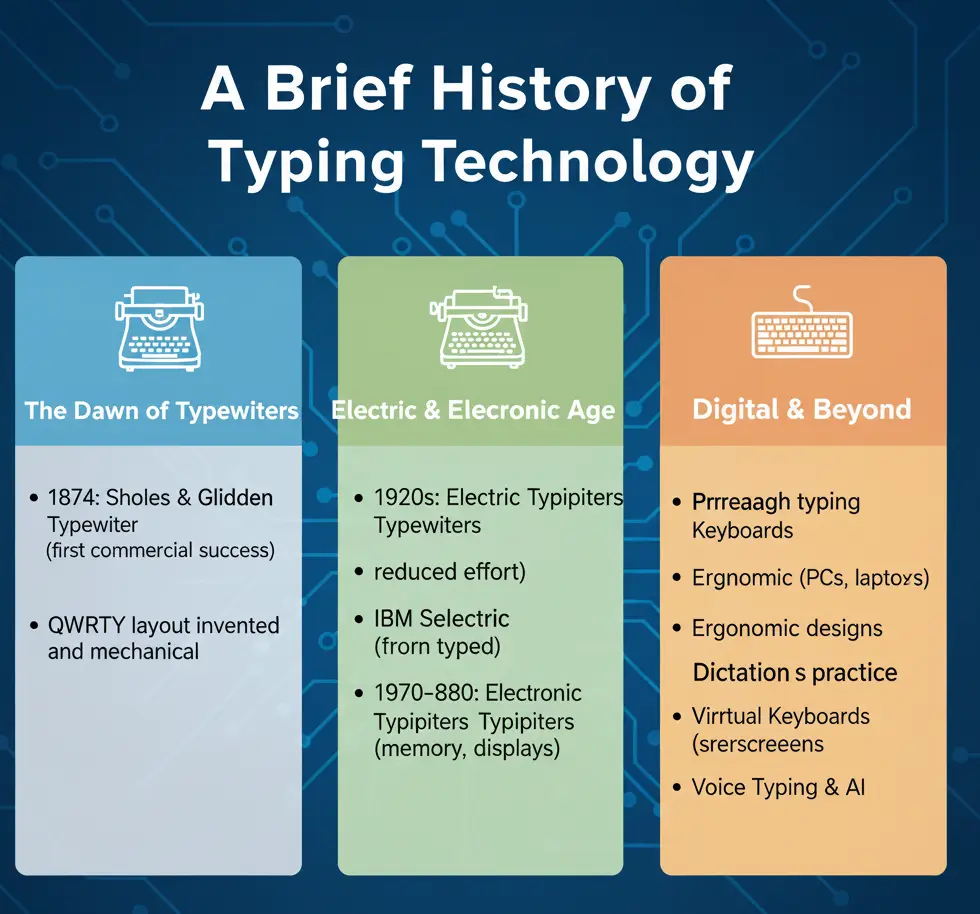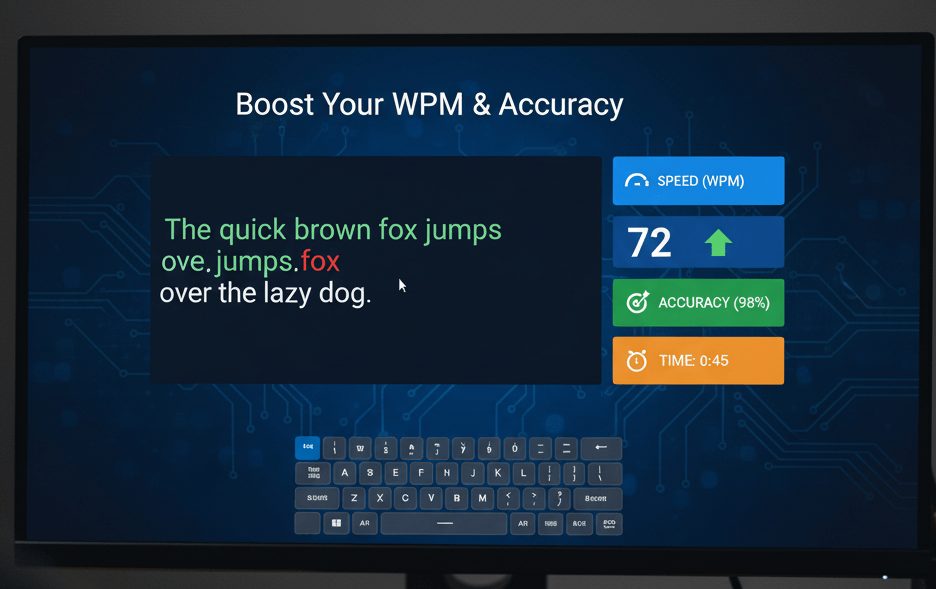History of Typing & The Tools That Taught Us
Typing is a skill that is the most precious treasure in the modern digital era. It has developed over 150 years and has an incredible history. It has updates time to time, modifications, and many still exist, and are divided into adaptations. You know it completely.

The Clunky, Clanky Beginning: Meet the Typewriter
Before computers, there was the typewriter. Imagine a heavy, metal box which was keys and by pressing a keys it typed on the paper and used in everywhere. A metal arm swings up and slaps an ink-soaked ribbon. The ribbon hits the paper. You get one letter. It was loud. It was manual. And it was a revolution.
In the 1870s, an inventor named Christopher Latham Sholes created one of the first commercially successful typewriters. His goal was simple: let people write faster and more clearly than they could by hand. Early models were strange. Some looked like pianos. Some had keys in alphabetical order. This seemed logical. A, B, C, D... easy, right? Wrong.
Jamming Keys was the Major Prolem
Alphabetical order had a huge flaw. In English, we use letter pairs like "TH," "ER," and "ON" all the time. When these keys were next to each other, the metal arms would swing up together. They would crash into each other. They would get stuck. The typist had to stop, untangle the metal arms, and start over. It was frustrating and slow.The Birth of QWERTY
Sholes and his team needed a solution. Their answer was not to make the machine faster. It was to make the typist slower.
They created a new layout. This layout was designed to be inefficient. They studied common letter pairs. Then, they moved those letters far apart. The "T" and "H" were separated. The "E" and "R" were split. The goal was to force the typist's fingers to move around the keyboard. This would slow them down just enough to prevent the machine from jamming.
This new layout started with the keys Q-W-E-R-T-Y. It was a total accident. It was a solution to a mechanical problem. It was never meant to be the fastest or most comfortable way to type. And yet, here we are, 150 years later, still using it.
The QWERTY layout became the standard. Why? Because the biggest typewriter manufacturer, Remington, adopted it. They were also famous for making sewing machines and rifles. They knew how to build and sell machines. Their typewriters spread across the world. And QWERTY went with them.
The Next Leap: Electric Typewriters and Early Computers
For decades, typing meant pounding on keys. It took real finger strength. Then, in the 1930s, the electric typewriter arrived. The IBM Selectric in the 1960s was the real game-changer. You didn't hit the paper directly. You just *tapped* a key. An electric motor did the heavy lifting. This was huge. Typing became faster. It became quieter. It required less effort.
This was the bridge to the digital age. When the first personal computers, like the Apple II and Commodore 64, arrived, they needed a way to input commands. The keyboard was the obvious choice. And what layout did they use? QWERTY, of course. By now, millions of people have been trained on it. It was the standard. There was no going back.
Keyboards Get Personal
This new era created a new culture. The "feel" of a keyboard became important. Early computer keyboards were mechanical. They had individual switches under each key. They made a satisfying click-clack sound. People loved them. Then, cheaper "membrane" keyboards were invented. These used rubber domes. They were quiet and cheap to make. They are what most laptops use today.
But many people missed the clicky feel. This led to a huge community of "mechanical keyboard" fans. They build custom keyboards. They trade different "switches" (Cherry MX, Gateron) that change the sound and feel of each press. It's a massive hobby, all focused on perfecting the feel of typing.
Let's Practice: Try a Quick Typing Test
All this history shows how our tools have changed. The best way to appreciate the journey is to practice the skill. This site is built to help you learn. Try a one-minute test on the history you just learned!
The Biggest Change: How We Learn to Type
The tools changed. But the way we learn changed even more. For generations, students learned in a classroom. They sat in rows of typewriters. An instructor would shout, "A, S, D, F, J, K, L, ;". You would type on blank paper. You couldn't see your mistakes until the end. It was slow. It was boring.
Then came the first typing software. Programs like "Mavis Beacon Teaches Typing" were a huge step. It was interactive. It showed you a keyboard on the screen. It gave you games to play. This was the start of "gamified" learning. It made practice fun.
The Rise of Online Typing Tools
The internet changed everything. Again. Today, you don't need to buy software. You open a website (like this one!). Online typing tools are the new standard. Why are they so effective for students?
- Instant Feedback: You know your speed (WPM) and accuracy right away. You don't wait for a teacher to grade your paper.
- Real-time Correction: You see mistakes the second you make them. This helps fix bad habits fast.
- Endless Practice: You can practice any time, anywhere. You are not limited to class time.
- Gamification: Many sites use points, levels, and high-score lists. This makes you want to beat your own score. It turns learning into a game.
This is why we built this site. We believe these modern tools are the best way to learn. They give you the power to teach yourself. You can see your progress. You can challenge your friends. You can improve every single day.
Beyond QWERTY: The Keyboards That "Lost"
Remember how QWERTY was designed to be slow? As soon as the jamming problem was solved, people tried to build a faster layout. The most famous one is the Dvorak layout.
Designed in the 1930s by August Dvorak, this layout is smart. It places all the most common letters on the "home row." (That's the A, S, D, F row). Vowels are on one side. Common consonants are on the other. This means your fingers move less. You can type thousands of words just by moving your fingers, not your whole hands. People who use Dvorak say it's faster and much more comfortable. So why don't we all use it?
The answer is simple: QWERTY got there first. By the time Dvorak was invented, millions of people and thousands of schools were already using QWERTY. The "cost" of switching was just too high. It's a perfect example of "path dependence." The first path stuck, even if it wasn't the best.
Other layouts exist, too. Colemak is a modern layout that is easier to learn than Dvorak. But QWERTY remains the king, for better or for worse.
The Future of Typing
Is typing even important anymore? We have voice-to-text on our phones. We have swipe keyboards. Surely, typing is a dying skill, right?
Not at all. Voice control is great for a short text message. But try writing an essay, a report, or a piece of code by talking to your computer. It's slow. It makes mistakes. And it's not private. Typing is still the fastest, most accurate, and most private way to get complex thoughts from your brain onto a screen.
The tools will keep evolving. We now have ergonomic split keyboards to protect our wrists. We have phones that predict our next word. But the core skill—knowing where the keys are without looking—is more valuable than ever. It's called touch typing.
This history matters because it shows that typing is not just a "computer class" skill. It's the skill of communication. Learning it is an investment. The tools have evolved from clunky metal to colorful websites. But the goal is the same: to make you a faster, more confident, and more powerful communicator. And that's a skill that will last a lifetime.
 Typing Practice Hub
Typing Practice Hub